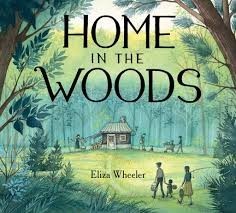This stunningly beautiful picture book from New York Times bestselling author-illustrator Eliza Wheeler is based on her grandmother's childhood and pays homage to a family's fortitude as they discover the meaning of home.
Eliza Wheeler's gorgeously illustrated book tells the story of what happens when six-year-old Marvel, her seven siblings, and their mom must start all over again after their father has died. Deep in the woods of Wisconsin they find a tar-paper shack. It doesn't seem like much of a home, but they soon start seeing what it could be.
During their first year it's a struggle to maintain the shack and make sure they have enough to eat. But each season also brings its own delights and blessings--and the children always find a way to have fun.
Most importantly, the family finds immense joy in being together, surrounded by nature. And slowly, their little shack starts feeling like a true home--warm, bright, and filled up with love.---from the publisher
40 pages 978-0399162909 Ages 5-8
Keywords: heritage, family, home, grandmother, nature, woods, survival, overcoming adversity, problem solving, love, possibilities, 5 year old, 6 year old, 7 year old, 8 year old, historical fiction, Depression Era, resilience, 20th century
************
“January is the coldest month of the year in Wisconsin, as it becomes exceedingly difficult to stay outdoors even for a few minutes. The temperatures are deathly cold, often dropping below -10°F (-23.3°C) and even plummeting to -30°F (-34.4°C) in the northern highlands.”
-- from “Monthly weather forecast and Climate Wisconsin USA” at weather-us.com
“Deep in the woods, we find a shack
all wrapped in tar paper.
It’s hot outside, but the shack
looks cold
and empty,
like I feel inside.
‘You’ll never know what treasures
we’ll find,’ says Mum.
In the shack, we don’t see
any treasures.
But Lowell and Eva find a door in the floor.
Below is a root cellar
filled with old glass jars,
a tin pail,
a pile of rags,
and a pitcher pump that goes
up and down,
up and down,
and out comes a stream
of cool, clear water.”
If you do an internet search for “10 Things to Consider Before You Buy a Fixer Upper,” you will discover an amusing photo of a long-abandoned dwelling with multiple conifers growing upward, bursting through its roof.
Depending upon the era and the locale, there have always been places where it is possible for kids to discover old, abandoned houses. I’ve read how, during the Roman Empire, children inadvertently made important archaeological discoveries of Ancient Greek culture while merely searching for props with which to play house.
As a child in mid-1960s suburban Long Island, and as an adult in mid-1980s Sonoma County, California, I had opportunities to wander through falling- and fallen-down homes, some of them with trees growing inside. I recently visited a cousin in upstate New York, and found that places with falling-down houses in the woods still exist today in quiet corners of the country.
Playing house comes as naturally to children as having a baby doll and playing mom. ROXABOXEN (1991) an old favorite of mine, written by Alice McLerran and illustrated by Barbara Cooney, portrays a neighborhood of kids who utilize rocks and some old wooden boxes to create an entire pretend neighborhood. This is imaginative play at its best.
While it evokes a similar feeling, HOME IN THE WOODS does not involve imaginary play. Based upon the life of the author’s grandmother, the story depicts a single mom and her eight children in Depression-era Wisconsin. On the death of the father, the family is forced to find a new home. They find a falling-down shack in the woods, and they move in.
I’m sure that the mother who was responsible for keeping these eight children housed, fed, and healthy, recognized, on some level, that the family was engaged in a life-or-death struggle. But no sense of such adult sensibilities ever creeps into this joy-filled account of siblings cooperating as they participate in all the tasks necessary to keep the family warm and fed.
This picture book story, which covers the four seasons of a single year, is narrated by Marvel, the six-year-old character who represents the author’s grandmother. In contrast to the rare glimpses of sadness, such as when the children look into a general store display window at all the alluring non-essentials they cannot afford, the story overflows with the excitement of new discoveries and the satisfaction of a job well done. These kids seem truly happy despite the absence of screens and plastic toys.
The illustrations are as notable as the text. They were created with dip pens, India ink, watercolors, acrylics, and pastel pencils. My favorite is of the children, who have wandered off into the woods, finding a wide expanse of ripe blueberries and raspberries, and proceeding to fill hats, pail, bag, and tummies with them. I love how the illustrations portray the haziness into which the woods fade as we peer into the distance.
We learn from the Author’s Note that the story takes place in 1932-1933, that the family lived in the shack for five years and that, as of the book’s writing, four of the eight siblings are still alive. The author concludes with a valuable pitch for learning one’s own family’s stories before it’s too late. I can readily imagine utilizing this book with K through 2 students as a conversation starter for having them go home and learn some of their own families’ histories.
Recommended by: Richie Partington, MLIS, California USA
See more of Richie's Picks https://richiespicks.pbworks.






